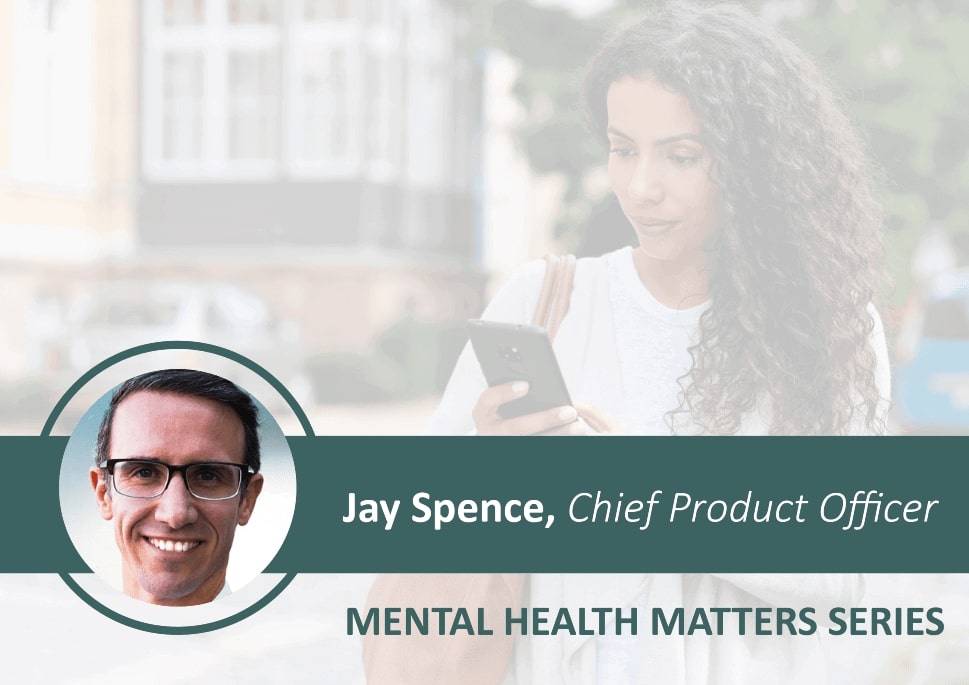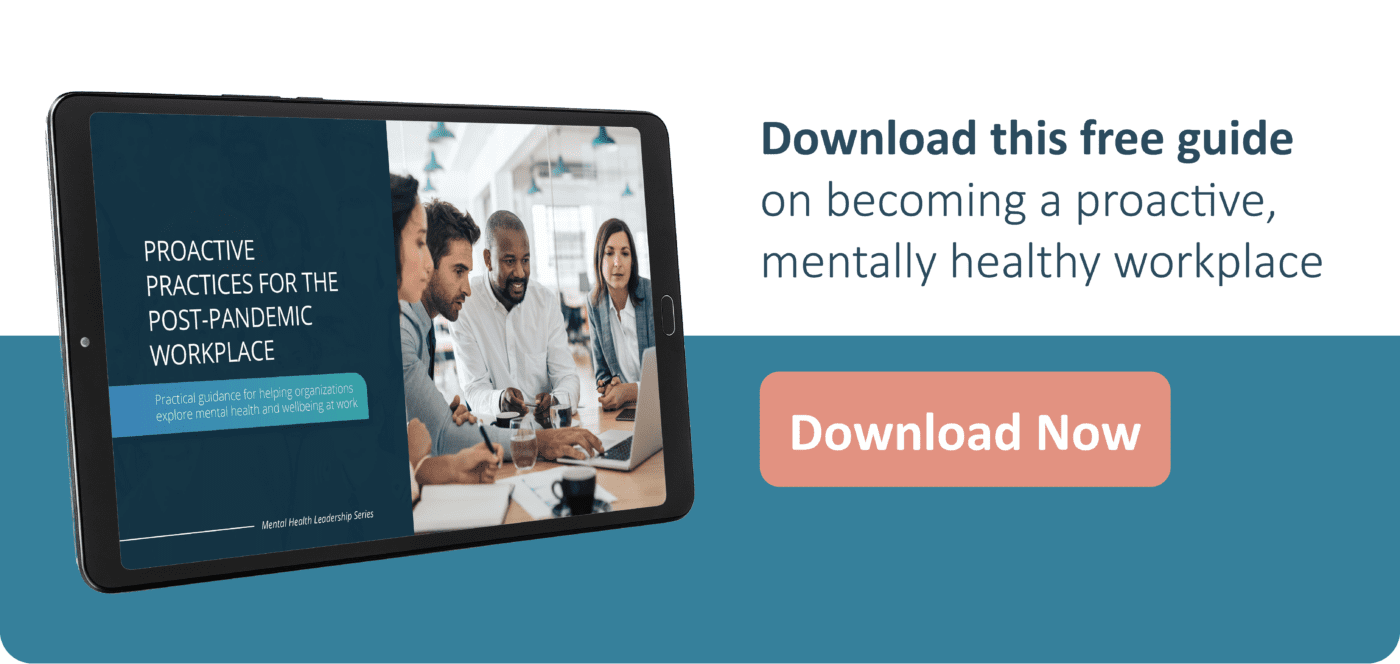This is the second of a series of articles from Uprise Health leaders about creating workplaces that value mental health. Over the coming weeks, we will explore the building blocks of culture and innovation, including shaping organizations that promote the mental health and wellbeing of their teams and clients.
Clinical psychologist, Dr. Jay Spence is the architect behind Uprise Health’s unique digitally enabled EAP program. Dr. Spence started his career as a clinical psychologist and found that when he was treating patients, a majority were seeking care too late in the progression of their mental illness. This realization was the catalyst for him to start a technology company to look at prevention and early intervention strategies to reduce the exacerbation of mental illness. Dr. Spence founded the mental health technology startup Uprise, specializing in proactive access to mental health support. Uprise was acquired by IBH in March 2021, which re-branded to Uprise Health later that year in October 2021. Jay has received several awards for his research in digital behavioral health, including the American National Invention and Innovation Award and the ANZ Mental Health Service Achievement Awards.
As Chief Product Officer for Uprise Health, Dr. Spence is responsible for developing innovative technology-based tools and solutions for Uprise Health’s wellness, EAP, behavioral health, substance abuse and opioid addiction products. Traditionally, Employee Assistance Programs (EAP) have been reactive services catering primarily to people in crisis. This approach to mental health requires an individual to ask for help, at a time when that is difficult to do.
The latest evidence-based digital therapies, data science and technology are leading the way for a different approach to mental health care. This new preemptive approach connects someone who is struggling to the resource most suited to their needs before they reach an emergency status. It also prioritizes mental health awareness and literacy among the wider population to prevent stress and burnout from worsening into more complex conditions. Most importantly, this innovative approach destigmatizes mental health issues so, like physical health, mental wellness becomes an important and normal part of our daily lives.
In our second Mental Health Matters blog, we had the opportunity to speak with the Chief Product Officer at Uprise Health, Dr. Jay Spence. Dr. Spence shares his insights as a leader in mental health technology and digital solutions on how innovation in this space will revolutionize the way Uprise Health cares for members. Technology enables us to pursue a transformation in mental health care and it serves as another tool to keep us mentally and physically healthy no matter where we are on our health journey.
5 Ways to Innovate Digital Mental Healthcare
Manage mental health risk like physical health risk.
Physically safe work environments are required by law. Physical safety means controlling risks and hazards to protect workers from physical harm. However, many employers don’t realize that keeping the workplace and work psychologically safe is also their responsibility. It is less common for workplaces to consistently measure and mitigate mental health risk factors. Increasingly, there has been an emphasis on the importance of classifying and supporting mental health with the same importance as any other safety hazard. Mentally healthy workplaces should aim to acknowledge and proactively manage mental health and safety as part of risk management.
According to Dr. Spence, “There is a coming movement to treat psychosocial hazards in the workplace in the same way that we’ve been thinking about physical hazards. Businesses know how to keep a workplace physically safe, and the smart ones are now looking at how to make it psychologically safe. Internationally there is a legislative trend that’s speeding that up.”
Uprise Health digital questionnaires measure mental health risk, calculates a risk score for employees. This score is used to trigger proactive outreach to employees identified as high risk so that they can be quickly connected to the appropriate resources. Additionally, these questionnaires identify work-related stressors that impact productivity and engagement. Once identified, the workplace can mitigate risk by making adjustments such as improving job design, implementing certain policies, or more clearly defining job roles.
Measure company wellbeing levels as a KPI
As the workplace invests more into employee wellbeing and the Chief People Officer role becomes more prevalent, wellbeing is increasingly tied to overall business strategy. When wellness initiatives are the foundation of an organization’s culture, employees feel that their well-being is important to their employer and they become more productive, engaged, and are able to reach their full potential.
“There are early adopter companies who see wellbeing levels as the new KPI for their organizations,” said Dr. Spence, “Many companies have heard about the Google study that showed psychological safety to be the best predictor of team performance so they are on the lookout for how to collect data that will optimize for that.”
Digital EAP and mental health technology solutions measure wellbeing in different ways. It is important that businesses seek a digital measurement solution that is evidence-based and reliable. The data collected should be synthesized in a way that is meaningful when tracked as a KPI. In addition, privacy policy must be stringent to protect sensitive wellbeing data and maintain the confidentiality of employees.
Streamline access to care
Some traditional EAP’s are complicated and inefficient and that can make it difficult for employees to access the care when they urgently need it. A member calls the EAP hotline, and they are given a list of counselors to contact. They must call them to figure out who is the right provider for their issue and if that provider has availability. Unfortunately, it is often difficult to get an appointment within a reasonable time.
“One-way companies are looking to solve the access to care problem is by creating real time booking systems. These systems shorten the time for people to access care from week-long wait times to just a matter of hours,” said Dr. Spence, “They also allow people to search for providers based on their preferences such as gender, language and specialization so there is a higher chance of building fundamental rapport with their first choice.”
Prioritize rigorous quality control
Right now, there is no transparency about the quality of a therapist and their outcomes. A person often needs to shop around until they find the right therapist who can provide the right quality of care for their issue. For a lot of people, reaching out for help is a huge step and if they don’t initially get a high-quality service, they conclude that it’s not worth trying again.
“I think that there is a trend towards higher transparency over therapist ratings and better explanations of how therapy actually works,” said Dr. Spence, “The industry is starting to provide better explanations to consumers that there is a set of evidence-based treatments for each diagnosis, explaining how these treatments work, what kind of progress they should expect, how to get the best outcomes from these treatments and which clinicians specialize in each treatment.”
Uprise Health measures the quality of providers through SMS therapist ratings which have produced a satisfaction rating of 96%. Learn more about Digitally Enabled EAP.
Coordinate physical and mental health care
The path to wellbeing is through an undeniable link between physical and mental wellbeing. Yet, most available solutions targeting either chronic or behavioral conditions fail to integrate assessment and care navigation across conditions. As a result, businesses and their employees are missing out on preventative, integrated services that could improve care outcomes and reduce workplace healthcare costs.
“If someone comes into an EAP with a workplace stress issue, the current model is to prioritize counseling. However, better care systems understand that the person’s mental health is multidetermined,” said Dr. Spence, “It might be due to a workplace issue but could also be due to financial stress, so you want a financial coach involved. Their mental health might also be making it hard for them to manage a chronic condition like diabetes. So ideally the more that multiple providers can cross refer and cross communicate then the more likely treatment and outcomes will be successful.”






